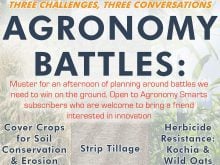RED DEER – Weeds across Western Canada are getting worse and as more land is disturbed, new enemies appear.
“Wherever there is human activity, whether it is recreational or industrial, that is where you are going to find weeds,” said Marian Jones with the Alberta department of sustainable development.
“Our vistas are no longer natural when invasive plants are present,” she said at a recent Alberta Synergy convention in Red Deer.
The Alberta weed control act is under review with new regulations expected soon to combat a growing number of foreign species that escape flowerbeds or farmers’ fields.
Read Also

VIDEO: Agritechnica Day 4: Robots and more robots, Nexat loves Canada and the trouble with tariffs
Agritechnica Day 4: Robots and more robots, Nexat loves Canada and the trouble with tariffs.
“People have this concept that if it is a nice looking plant, it belongs there,” she said.
Under Alberta law, the owner or occupant of the land is responsible for destroying restricted weeds. In recent years the province, through sustainable resources, hired a person to look after weed control on crown land. Weed surveys are done and occupants are reminded of their obligations for weed control. The department also hires applicators to spray weeds.
Jones and others in the department have started organizing teams to deal with weeds in specific areas.
These teams are aimed at bringing together oil and gas, forest industry, agriculture fieldmen and others to tackle weeds in a specific area.
They identify leaseholders in an area and get everyone to agree to treat weeds on their property in the same season.
“It is all or nothing. If one refuses to participate, no one else has to spray,” Jones said.
One area showing success working with industry is Wheatland County, east of Calgary. A weed control committee started in 2003 after a dispute between a landowner and an energy company. That group has drawn up a landowner expectations document outlining what industry needs to know about weed control.
Infestations often follow industrial development like roads, pipelines or well sites.
Resource industries have a responsibility to keep their areas free of weeds and agriculture fieldmen can issue notices to clean up an area. But the notice does not always carry much weight, so those wanting weeds removed must be persistent.
“It has been slow to raise the awareness both inside and outside government. There has been reluctance among some leaseholders because it costs them money,” Jones said.
When leases are negotiated, a weed survey of the area should be done so when the area is reclaimed, everyone knows what was there and what was introduced.
It can be difficult to determine who introduced the weeds because some seeds can remain in the soil a long time. A landowner may demand that companies wash equipment before entering a site.
In 2004, the Alberta Research Council estimated there were 296 non-native plants species in the province. Of that number, about 50 were invasive and cost the economy $1 billion in lost productivity and controls.
A common weed is the yellow buttercup. Livestock cannot eat it because it causes lesions on the mouth and in the intestinal tract.
Dried houndstongue, another invader, may release a toxin that does irreversible liver damage to livestock.
The latest problem is wild caraway. It started as a spice that escaped farmers’ fields and is invading western Alberta.
“It is an any time of the year plant. The seeds germinate all year round. It is incredibly invasive,” Jones said.
It can grow in shade and tolerates varied conditions.
It is not on the provincial weed list, although some municipalities list it as a noxious weed. She suspects it arrived with hay.
Caraway has carrotlike leaves with tiny white flowers that look like a small cow parsnip. It goes unnoticed until it is in bloom.
Horses and cattle won’t eat it until it has cured and starts producing seeds, leading some to suspect it gets spread in manure.
“Infestations are showing up out of the blue,” she said.
For more information on weed control and identification, visit www.umbel.ca or www.invasiveplants.ab.ca.















